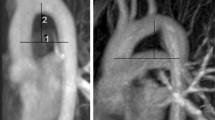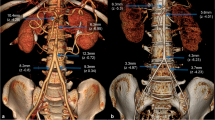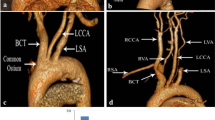Abstract
Background
Only a few studies, involving small numbers of patients, have globally assessed the curvature of the thoracic aorta but without any details concerning the location of the supra-aortic trunks.
Objectives
Using CT to describe normal aortic-arch morphology and its changes with age and sex.
Methods
344 CT scans were studied. We measured the distances from the apex to the ascending and descending aorta, the curvilinear length of the entire arch, that of the segment, including bifurcations of supra-aortic vessels, and the angle, height, and shift of the arch.
Results
In men, the arch was significantly longer (146.2 vs 122.8 mm; p < 0.001), higher (49.3 vs 40.1 mm, p < 0.001), and wider transversely (83.6 vs 73.3 mm; p < 0.001) than in women. The average men’s arch also had a more acute angle at the apex (79.7° vs 83.7° p < 0.001). Neither morphology nor age influenced the winding angle around the mediastinum. Aging was accompanied by deflection and extension of the aortic arch, which grew more anteroposteriorly (6.1 mm/10 years in men) than vertically (2.5 mm/10 years in men), while the apex moved towards the rear of the arch. The ascending aorta was the only curvilinear length unaffected by age, whereas the supra-aortic trunks parted from each other.
Conclusion
We believe that all these original observations could lead to a better assessment of normal aging of the aorta and guide technical choices during surgical or hybrid procedures.



Similar content being viewed by others
Abbreviations
- AC:
-
Ascending aortic-arch length
- ACD:
-
Apex angle of the aortic arch
- ACsD:
-
Helix angle of the aortic arch
- AD:
-
Transverse length of the aortic arch
- BCT:
-
Brachiocephalic arterial trunk
- BMI:
-
Body mass index
- BSA:
-
Body-surface area
- CCp:
-
Aortic-arch height
- CD:
-
Descending length of the aortic arch
- CDA:
-
Descending angle of the aortic arch
- CT Scan:
-
Computed tomography scan
- DAC:
-
Ascending angle of the aortic arch
- LCCA:
-
Left common carotid artery
- LSCA:
-
Left subclavian artery
- PACS:
-
Picture archiving and communication system
References
Casciaro ME, Craiem D, Chironi G et al (2014) Identifying the principal modes of variation in human thoracic aorta morphology. J Thorac Imaging 29:224–232. doi:10.1097/RTI.0000000000000060
Claudot F, Alla F, Fresson J et al (2009) Ethics and observational studies in medical research: various rules in a common framework. Int J Epidemiol 38:1104–1108. doi:10.1093/ije/dyp164
Craiem D, Chironi G, Redheuil A et al (2012) Aging impact on thoracic aorta 3D morphometry in intermediate-risk subjects: looking beyond coronary arteries with non-contrast cardiac CT. Ann Biomed Eng 40:1028–1038. doi:10.1007/s10439-011-0487-y
Garcier J-M, Petitcolin V, Filaire M et al (2003) Normal diameter of the thoracic aorta in adults: a magnetic resonance imaging study. Surg Radiol Anat 25:322–329. doi:10.1007/s00276-003-0140-z
Hager A, Kaemmerer H, Rapp-Bernhardt U et al (2002) Diameters of the thoracic aorta throughout life as measured with helical computed tomography. J Thorac Cardiovasc Surg 123:1060–1066. doi:10.1067/mtc.2002.122310
Hinchliffe RJ, Krasznai A, Schultzekool L et al (2007) Observations on the failure of stent-grafts in the aortic arch. Eur J Vasc Endovasc Surg 34:451–456
Lin FY, Devereux RB, Roman MJ et al (2008) Assessment of the thoracic aorta by multidetector computed tomography: age- and sex-specific reference values in adults without evident cardiovascular disease. J Cardiovasc Comput Tomogr 2:298–308. doi:10.1016/j.jcct.2008.08.002
Malkawi AH, Hinchliffe RJ, Yates M et al (2010) Morphology of aortic arch pathology: implications for endovascular repair. J Endovasc Ther 17:474–479
Melissano G, Bertoglio L, Civilini E et al (2007) Results of thoracic endovascular grafting in different aortic segments. J Endovasc Ther Off J Int Soc Endovasc Spec 14:150–157. doi:10.1583/1545-1550(2007)14[150:ROTEGI]2.0.CO;2
Mosteller RD (1987) Simplified calculation of body-surface area. N Engl J Med 317:1098. doi:10.1056/NEJM198710223171717
Rogers IS, Massaro JM, Truong QA et al (2013) Distribution, determinants, and normal reference values of thoracic and abdominal aortic diameters by computed tomography (from the Framingham Heart Study). Am J Cardiol. doi:10.1016/j.amjcard.2013.01.306
Rylski B, Desjardins B, Moser W et al (2014) Gender-related changes in aortic geometry throughout life. Eur J Cardiothorac Surg. doi:10.1093/ejcts/ezt597
Rylski B, Blanke P, Beyersdorf F et al (2014) How does the ascending aorta geometry change when it dissects? J Am Coll Cardiol. doi:10.1016/j.jacc.2013.12.028
Schlatmann TJ, Becker AE (1977) Histologic changes in the normal aging aorta: implications for dissecting aortic aneurysm. Am J Cardiol 39:13–20
Shrout PE, Fleiss JL (1979) Intraclass correlations: uses in assessing rater reliability. Psychol Bull 86:420–428
Stefanadis C, Stratos C, Vlachopoulos C et al (1995) Pressure-diameter relation of the human aorta. A new method of determination by the application of a special ultrasonic dimension catheter. Circulation 92:2210–2219
Stefanadis C, Dernellis J, Vlachopoulos C et al (1997) Aortic function in arterial hypertension determined by pressure-diameter relation: effects of diltiazem. Circulation 96:1853–1858
Stefanadis C, Dernellis J, Tsiamis E et al (2000) Aortic stiffness as a risk factor for recurrent acute coronary events in patients with ischaemic heart disease. Eur Heart J 21:390–396. doi:10.1053/euhj.1999.1756
Wolak A, Gransar H, Thomson LEJ et al (2008) Aortic size assessment by noncontrast cardiac computed tomography: normal limits by age, gender, and body surface area. JACC Cardiovasc Imaging 1:200–209. doi:10.1016/j.jcmg.2007.11.005
Author information
Authors and Affiliations
Corresponding author
Ethics declarations
The authors of this manuscript declare no relationships with any companies, whose products or services may be related to the subject matter of the article. The authors state that this work has not received any funding. This descriptive, retrospective monocentric study was conducted according to ethical principles for medical research involving human subjects in French university hospitals (Claudot F, et al. Ethics and observational studies in medical research: various rules in a common framework. Int J Epidemiol 2009, 38(4):1104–1108.)
Rights and permissions
About this article
Cite this article
d’ostrevy, N., Ardellier, F.D., Cassagnes, L. et al. The apex of the aortic arch backshifts with aging. Surg Radiol Anat 39, 703–710 (2017). https://doi.org/10.1007/s00276-016-1792-9
Received:
Accepted:
Published:
Issue Date:
DOI: https://doi.org/10.1007/s00276-016-1792-9




